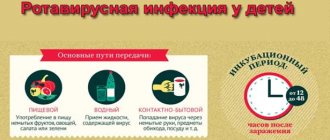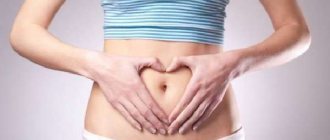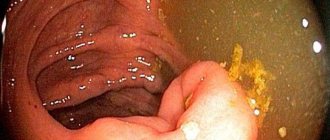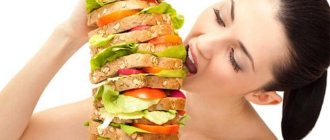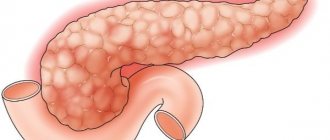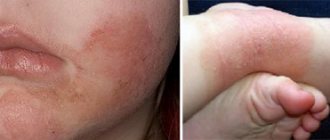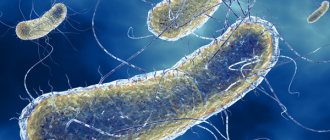Pancreatitis in children occurs with the development of an inflammatory reaction in the tissues of the pancreas. In childhood, this pathology is often disguised as other diseases of the digestive tract (gastroduodenitis, gastritis, dysbacteriosis) and can occur for a long time with minor symptoms.
If signs of pancreatitis appear in children, you should contact a pediatrician or pediatric gastroenterologist. Without treatment, the disease becomes chronic and can cause complications, including pancreatic necrosis (a complication of acute pancreatitis with destruction of pancreatic tissue)1.
Reasons for the development of pancreatitis in a child
Pancreatitis in children develops under the influence of various external and internal unfavorable factors2:
- poor nutrition, overeating, excess fatty, spicy and overly spicy foods in the diet;
- severe allergic reactions to medications, food, environmental factors;
- congenital or acquired anomalies of the digestive organs;
- damage to the abdominal wall;
- progression of other gastrointestinal diseases*;
- benign and malignant neoplasms in the pancreas;
- helminthiases;
- endocrinological diseases;
- past viral diseases;
- hormonal disorders;
- uncontrolled use of medications.
Regardless of the reasons for the development of pancreatitis in children, the child needs qualified medical care and a comprehensive examination.
Based on diagnostic data, specialists identify factors that provoke an inflammatory reaction in the pancreas, select an effective treatment regimen, and carry out prophylaxis to prevent further relapses.
Acute pancreatitis in children
The acute form of pancreatitis can develop as a result of an infectious lesion of the body against the background of damage to the pancreas. The disease often occurs after overeating and eating excessively fatty foods, as well as against the background of viral infections and helminth infections.
Acute inflammation of the gland is accompanied by a pronounced destructive-inflammatory process. The child must be hospitalized to avoid the development of complications and serious disturbances in the functioning of the digestive system2.
Timely consultation with a doctor will help to avoid negative consequences, for example, the development of purulent peritonitis (infectious inflammation of the peritoneum).
Traditional medicine
Alternative medicine prescriptions can only be used for children over four years of age. When selecting specific products, it is important to take into account the individual characteristics of the body (for example, the presence of food allergies).
Traditional methods can be used as a supplement, but not used as the main method of treating inflammation.
Examples of folk remedies:
- honey with herbs (50 g each of calamus and dandelion roots mixed with thyme, nettle root and hops (25 g each), it is recommended to grind the ingredients into powder, add 200 g of honey to the prepared mixture, take a teaspoon twice a day);
- corn silk, calendula and chamomile (combine the components in equal parts, pour boiling water over a teaspoon of the mixture, leave, after straining, take in small portions before each meal);
- dill seeds, chamomile and hawthorn berries (combine the ingredients in equal proportions, pour boiling water over a tablespoon of the preparation, leave in a thermos, take several times a day before meals).
Chronic pancreatitis in children
Signs of chronic inflammation of the pancreas in children are determined primarily by the form of the disease and the condition of other organs of the digestive tract. Typically, children are bothered by aching pain under the chest, which intensifies after eating fatty and spicy foods, physical and psycho-emotional fatigue.
Chronic pancreatitis in childhood most often develops against the background of unfavorable heredity. If parents and close relatives develop a similar disease, the risk of its development in the child increases significantly.
The chronic course of the inflammatory process can lead to irreversible changes in pancreatic tissue and dysfunction of the organ. If characteristic signs of exacerbation appear, such as abdominal pain, bitterness in the mouth, vomiting, frequent and loose stools, you should contact a specialist. Self-medication may increase the inflammatory response.
Classification
Childhood pancreatitis can manifest itself in acute or chronic form (each type has its own characteristics of symptoms and differs in the degree of damage to the digestive tract). Based on the nature of changes in the tissues of the gland, purulent, acute edematous, hemorrhagic and fatty pancreatic necrosis are distinguished. This classification is carried out taking into account the complications of the disease. Depending on the speed of development, DP can be latent or recurrent.
Classification according to origin:
- hereditary type (autosomal domain transmission);
- secondary form (against the background of inflammatory processes in other organs);
- primary type (manifests as an attack of acute pancreatitis).
Reactive pancreatitis in children
Reactive pancreatitis develops in children against the background of other diseases of the gastrointestinal tract, toxic damage (for example, due to drug poisoning), or an allergic reaction. In the overwhelming majority, the cause of the inflammatory process lies in the exacerbation of cholelithiasis and liver diseases.
Reactive pancreatitis develops several hours after adverse effects of internal and external factors. The following symptoms are noted3:
- pain that increases after eating;
- signs of gas formation;
- heartburn;
- nausea turning into vomiting;
- traces of bile and mucus in the vomit.
Fever
- Digestive disorders: diarrhea, bloating, constipation.
- Symptoms of peritoneal irritation.
- Ascites – the appearance of fluid in the abdominal cavity
- Jaundice: the skin and mucous membranes become yellowish.
- Pleural effusion is fluid in the pleural cavity.
- Paleness of the skin.
- Lack of appetite.
Of these symptoms, epigastric pain and nausea are almost half as common in newborns and infants, but fever is more common in children of this age group.
Diagnosis of pancreatitis in children
The diagnosis is made based on the clinical picture, the results of the survey, examination of the child and the data of the examination. When palpating the abdomen, the gastroenterologist detects local pain in the epigastric region (in the upper and middle parts of the abdomen, between the costal arches). In order to identify concomitant pathologies of the digestive organs, specialists can also prescribe2:
- general radiography of the gastrointestinal tract*;
- computed tomography;
- Ultrasound;
- MRI**.
Treatment of pancreatitis in children
The choice of treatment methods for pancreatitis in children requires a careful study of the medical history, examination data and examination of the child. The acute form of the disease often requires hospitalization of the child. The inflamed pancreas needs rest, which can only be ensured by strict adherence to the following conditions2:
- bed rest;
- diet;
- possible short-term therapeutic fasting;
- drug treatment, including the administration of glucose, painkillers and anti-inflammatory drugs, as well as drugs intended to normalize digestion, for example, the drug Creon®.
In case of severe destruction (impaired functioning) of the pancreas, urgent surgical treatment is required.
Due to the high risk of complications, pancreatitis in childhood requires specialist supervision. Even if the symptoms of the inflammatory process are mild, it is necessary to consult a specialist to prevent undesirable consequences.
Gastroenterologists pay special attention to the development of measures to prevent exacerbations of pancreatitis in children. Prevention includes maintaining a balanced diet appropriate for the child’s age, preventing toxic damage to the body as a result of infectious processes and the course of diseases of internal organs.
Treatment methods
Therapy for DP includes medications, conservative methods and surgery. If the diagnosis is confirmed, the child should be treated in a hospital under the supervision of doctors. The duration of hospitalization depends on the degree of damage to the digestive system. After discharge, parents are given recommendations, compliance with which will help prevent repeated attacks of the inflammatory process. Some alternative medicines are allowed to be used as an addition to primary therapy.
Conservative treatment
The goal of conservative treatment of DP is to provide the affected organ with functional rest, relieve symptoms of inflammation and eliminate the causes of its occurrence. During the therapy period, measures are taken to prevent chemical or mechanical effects on the digestive tract. On the first day, the child is recommended to take a “food break” (fasting for two to three days). It is allowed to drink alkaline mineral waters without gas. Nutrition begins on the third day with gentle foods and small portions.
Other conservative treatment measures:
- intravenous administration of glucose solutions and proteolytic enzyme blockers (Contrical);
- bed rest and complete rest of the body;
- fasting for 48 hours after hospitalization.
Drug treatment
Drug therapy for DP is carried out not only to relieve the symptoms of the disease, but also to improve the functional state of the digestive system. Drugs are selected individually. If there are complications, the treatment regimen is supplemented with antibiotics. In hospital settings, most medications are prescribed to children by injection.
You can take tablet medications only after restoring your diet.
Examples of drugs for the treatment of DP:
- antisecretory agents (Famotidine, Pirenzepine);
- antispasmodics and analgesics (Papaverine, No-shpa, Analgin, Baralgin);
- antihistamines;
- means for improving microcirculation (Pentoxifylline);
- pancreatic enzyme preparations (Pancreatin);
- antibiotics;
- protease inhibitors (Pentoxyl).
Surgery
Surgical intervention is used in the presence of serious complications of DP and the failure of other treatment methods. Surgeries may involve resection of part of the affected organ, drainage of an abscess in tissue, or removal of a necrotic area. Surgical procedures are radical measures and in the treatment of children they are used only if there is a threat to the life of the small patient.
Diet for pancreatitis in children
With pancreatitis, the child must follow a diet.
The following foods and drinks are excluded2:
- fresh bread and pastries;
- sparkling water;
- fatty dairy products;
- smoked meats, seasonings and spices;
- store-bought juices;
- fat meat;
- cabbage;
- lemons;
- credit;
- legumes;
- coffee.
Slimy porridges prepared with vegetable decoctions are useful. You can use meat broths made from poultry (skinless chicken), veal, rabbit, which are previously steamed or boiled. During an exacerbation, food should be pureed and free of lumps and rough pieces that can injure the mucous membrane of the digestive tract.
Treatment prognosis
With a mild form of pancreatitis and timely treatment, the prognosis for children is favorable. Pathology can be eliminated forever if it is diagnosed in time and appropriate treatment measures are taken. Purulent inflammatory processes or complications can cause the death of a child.
Ignoring the disease can cause serious damage to the digestive tract.
Possible complications:
- false cyst;
- pleurisy;
- peritonitis;
- phlegmon;
- abscess;
- diabetes.

